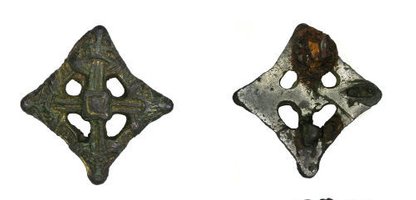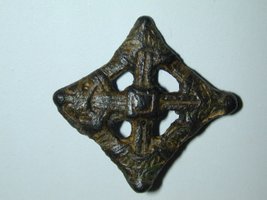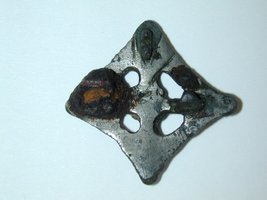Anglo-Scandinavian lozenge brooch.
This brooch had been reported to the PAS and I attach the tekst written there integral here:
Near complete cast copper alloy brooch of later Early Medieval date; deemed Anglo-Scandinavian in cultural terms. The brooch is lozengiform in plan with openwork decoration. The brooch has a single stylised zoomorphic head at each corner of the lozengiform, the moulded detail of each of these, especially the area between the eyes and ears is slightly different, otherwise they are very similar with each one having a rounded protruding nose, raised ridge running up from this forming the snout or nose and a prominent brow ridge at the top of this. This arrangement forms shallow hollows for the eyes to either side of the snout. From the rear of each head there is a rectangular strip projecting inwards, 3 with one central groove for decoration and one with 2 grooves for decoration. These four strips abut a central, slightly raised, square shaped boss, therby forming an openwork cross arrangement. The square boss is plainly decorated with a single incised groove forming a smaller square in the centre of the boss.
The four heads are further linked together by strips of rectangular decoration protruding diagonally from the top of both sides of each head, forming the sides of the overall lozenge shape. It may be that these side strips are intended to be ears or antlers with each one being shared by two heads. There are traces of gilding surviving in the grooves of the design on the front of the brooch. The reverse of the brooch, which is flat stil has considerable surviving silvering. The pin fittings of the brooch survive on the reverse of the brooch and consist of two semi-circular lugs to hold the hinge in place and a small triangular shaped catchplate which is bent for securing, the now missing pin in position. The hinge fittings have ferrous corrosion between and around them, indicating that the pin was iron. There is a further fitting on the reverse consisting of a broken semi-circular lug with central, incomplete circular piercing. This does not appear to be a later addition, so is not a modification when the brooch pin was lost so may have been for the suspension of a now missing part of the brooch - perhaps a suspended chain, although this cannot be certain.
Brooches of this type have been found in both the Danelaw parts of England and in Scandinavia and are dated to the 9th to 10th centuries, c.850-1000 AD.
Dimensions and weight:
Length: 34 mm
Width: 32.7 mm
Thickness: 3.3 mm
Weight: 7.9 g
Spatial metadata
Region: East Midlands (European Region)
County or Unitary authority: Nottinghamshire (County)
District: Newark and Sherwood (District)
To be known as: Clipstone
Well. I could have been with these stones until after dark, but as my wife wanted to travel on.. well.. I see you again, some day, hogback stones from Gosforth. And if you happen to be there one day, do not forget that monument on the outside...
Further on with the Cumbrian hogbacktour !
In - yes, luckily again in - St. Peter's church in Heysham, there is a truly beautiful hogback stone. The guide told us, it had been studyied by Thor Ewing, a writer, in 2000. in 'Understanding the Heysham hogback' A tenth century sculpted stone monument and its context (link), Thor Ewing tells in detail what he dicovered on the both sides of this hogback stone.
Just being brought in the church as late as the 1970's accompanied with some protest here and there among the church visitors, considered as being a token of old paganism, it had been remarkably nice preserved, and a lot of detail can be seen, still. Truly worthwile a visit.
I had a small debate with the guide in the church if the - zoomorphic, in my opinion - faces on the sides were lions (or hippo's). The guide doubted if the vikings could have known about lions. Well I guess so, concerning the runes on the Ancient Greek lion statue at the Arsenal, Venice. For example. Vikings did travel south..
But when he told me he was doubting the vikings 'discovered' (as the native inhabitants were of course, in the first place) America before Columbus, I decided to rest my case..
One has to know when to start and to end a conversation ..
Just discovered the book in a bookstore written by Geoff Holder - The guide to the mysterious Lake District, I knew there had to be another hogback stone in Lowther, St. Micheal's Church. With a promising image described in the text of 'a naval and a land-based force of shield-bearing vikings above a fish and what might be a coiled sea serpent. On the reverse is a row of female figures with snakes, possibly a representation of the hideous hag Hel'. Wow. If that did not sound as a true pagan promised land ..
Not complaing too much after all we have seen, this visit was the dissapointing one of them all. But if you wife states 'I am happy to have seen them' and I am answering 'Measuring is knowing' and the even more obligate verb 'handling 'if we did not see it at all, we wouldn't have known anything at all of how they were looking' the glass was again half full, at the last day of our journey..
The hogback stone appeared to be just being tolerated within the entrance segment part of the church. As something you never use anymore but you do not throw away - entirely. That sort of feeling emerged when seeing this hogback asylum seekers.. Bed, bath and bread, ás we say in Dutch, but no luxury at all and standing on some outcuts of wood, you would balance the table with at home..
Come on, St. Micheal's Church.. care a bit more of your 'children' !
This hogback stone was moved in the church in 1907. Hogback stones layed partially buried in the churchyard before it was dug up and moved into the church.
The promising depiction of a longship - as certainly can be seen after some studying - see http://vikingminds.co.uk/pages/longship
we have missed !
The stone itself is (157 x 50 x 30 cm) and very worn.
The hogback stones in Cumbria - very diverse in quality, but everyone worth a visit ! Especially on a gloomy day in late October ...
The churches to visit - see photos of resp. St. Andrew's church in Penrith, St. Mary's church in Gosforth, St. Peter's church in Heysham and St. Micheal's church in Lowther.
Did I miss out on another one in Cumbria ? Let me know !
In a next blog I will take you to four - still remaining utterly mysterious- statues 'guarding' the graveyard of St. Andrew's church in Dacre..
For the last blog of October 9th see this link.
References: (as always, links to where the books can be ordered are attached).
Edwards, B.J.N. Vikings in North West England - The artifacts (1998);
Emery, Gordon, CURIOUS CUMBRIA, The Lake District & Beyond: A celebration of Cumbria (2023)
Ewing, T. 'Understanding the Heysham hogback' A tenth century sculpted stone monument and its context ;
Hall, R. Viking Age archaeology in Britain and Ireland (first printed 1990, reprinted with amendments in 1995);
Holder, G. The guide to the mysterious Lake District (2009)
possibly also (as there within the part of Cumbria dealing with Carlisle, the Eden Valley, Barrow-in-Furness, Whitehaven and the west coast is being dealed with)
Holder, G. Paranormal Cumbria (2010)
http://vikingminds.co.uk/pages/longship


